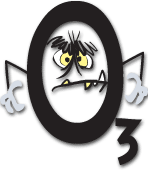
Oxygen—a Pollutant?

Oxygen, a gas that we inhale with every breath, is essential to life on Earth. But as a chemical, oxygen is reactive. That property makes it life-sustaining and also a source of pollution.
A single molecule of oxygen (O2) contains two oxygen atoms. But add another oxygen atom, and you have ozone (O3). In the stratosphere, ozone protects us, absorbing much of the sun’s harmful ultraviolet radiation. But at ground level, in the troposphere, carried in the air we breathe, ozone is a poison that burns and corrodes living and non-living things.
Small amounts of ozone develop naturally, especially during lightning storms, but spew industrial chemicals and automobile exhausts into the atmosphere, cook them with heat and sunlight, and ozone levels can rise dangerously high. Ozone is the main component of “photochemical smog.”
Exhaustive
On-road vehicles, including trucks, buses, cars, and motorcycles, are responsible for 29 percent of the volatile hydrocarbons (VOCs) and 34 percent of the nitric oxide and nitrogen dioxide (known collectively as NOx) that contribute to the formation of ground-level ozone.

- Photo © Jose Luis Pelaez, Inc./CORBIS
